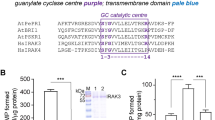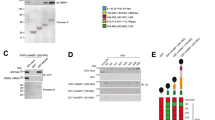Abstract
Nuclear factor κB-inducing kinase (NIK) is a member of the MAP kinase kinase kinase family that was first identified as a component of the TNF-R1-induced NF-κB activation pathway (TNF, tumor necrosis factor; nuclear factor kappaB, NF-κB). Gene knockout study, however, suggests that NIK is dispensable for TNF-R1- but required for lymphotoxin-β receptor-induced NF-κB activation. A NIK kinase inactive mutant is a potent inhibitor of NF-κB activation triggered by various stimuli, suggesting that NIK is involved in a broad range of NF-κB activation pathways. To unambiguously identify signaling pathways that NIK participates in, we screened antibody arrays for proteins that are associated with NIK. This effort identified ErbB4, one of the EGF/heregulin receptors, and Grb7, an adapter protein associated with ErbB4 (ErbB, epidermal growth factor receptor family protein; EGF, epidermal growth factor; Grb, growth factor receptor bound). Coimmunoprecipitation experiments demonstrated that NIK interacted with Grb7, as well as Grb10 and Grb14, but not Grb2. Domain mapping experiments indicated that the central GM domain of Grb7 was sufficient for its interaction with NIK. Coimmunoprecipitation experiments also indicated that Grb7 and NIK could be simultaneously recruited into signaling complexes of all known EGF/heregulin receptors, including EGFR, ErbB2, ErbB3, and ErbB4. In reporter gene assays, NIK could potentiate Grb7, ErbB2/ErbB4, and EGF-induced NF-κB activation. A NIK kinase inactive mutant could block ErbB2/ErbB4 and EGF-induced NF-κB activation. Moreover, EGF/heregulin receptors activated NF-κB in wild-type, but not NIK−/− embryonic fibroblasts. Our findings suggest that NIK is a component of the EGF/heregulin receptor signaling complexes and involved in NF-κB activation triggered by these receptors.
This is a preview of subscription content, access via your institution
Access options
Subscribe to this journal
Receive 50 print issues and online access
$259.00 per year
only $5.18 per issue
Buy this article
- Purchase on Springer Link
- Instant access to full article PDF
Prices may be subject to local taxes which are calculated during checkout






Similar content being viewed by others
Abbreviations
- NIK:
-
nuclear factor κB-inducing kinase
- Grb:
-
growth factor receptor bound
- EGFR:
-
epidermal growth factor receptor
- ErbB:
-
epidermal growth factor receptor family protein
- EGF:
-
epidermal growth factor
- TRADD:
-
tumor necrosis factor associated death domain protein
- RIP:
-
receptor interacting protein
- TNF:
-
tumor necrosis factor
- NF-κB:
-
nuclear factor kappaB
- STAT:
-
signal transducers and activators of transcription
References
Akiyama N, Sasaki H, Ishizuka T, Kishi T, Sakamoto H, Onda M, Hirai H, Yazaki Y, Sugimura T and Terada M . (1997). Cancer Res., 57, 3548–3553.
Antwerp DJ, Martin SJ, Kafri T, Green DR and Verma IM . (1996). Science, 274, 787–789.
Beg AA and Baltimore D . (1996). Science, 274, 782–784.
Berezia V, Kasus-Jacobi A, Perdereau D, Cariou B, Girard J and Burnol AF . (2002). J. Biol. Chem., 277, 4845–4852.
Biswas DK, Cruz AP, Gansberger E and Pardee AB . (2000). Proc. Natl. Acad. Sci. USA, 97, 8542–8547.
Chen D, Li X, Zhai Z and Shu HB . (2002). J. Biol. Chem., 277, 15985–15991.
Daly RJ . (1998). Cell. Signal., 10, 613–618.
Daly RJ, Sanderson GM, Janes PW and Sutherland RL . (1996). J. Biol. Chem., 271, 12502–12510.
Dong LQ, Du H, Porter SG, Kolakowski Jr LF, Lee AV, Mandarino LJ, Fan J, Yee D, Liu F and Mandarino J . (1997). J. Biol. Chem., 272, 29104–29112.
Fiddes RJ, Campbell DH, Janes PW, Sivertsen SP, Sasaki H, Wallasch C and Daly RJ . (1998). J. Biol. Chem., 273, 7717–7724.
Frantz JD, Giorgetti-Peraldi S, Ottinger EA and Shoelson SE . (1997). J. Biol. Chem., 272, 2659–2667.
Habib AA, Chatterjee S, Park SK, Ratan RR, Lefebvre S and Vartanian T . (2001). J. Biol. Chem., 276, 8865–8874.
Han DC and Guan JL . (1999). J. Biol. Chem., 274, 24425–24430.
Han DC, Shen TL and Guan JL . (2000). J. Biol. Chem., 275, 28911–28917.
Han DC, Shen TL and Guan JL . (2001). Oncogene, 20, 6315–6321.
Hill CS and Treisman K . (1995). Cell, 80, 199–211.
Hoffmann M, Schmidt M and Wels W . (1998). Cancer Immunol. Immunother., 47, 167–175.
Jahn T, Seipel P, Urschel S, Peschel C and Duyster J . (2002). Mol. Cell. Biol., 22, 979–991.
Janes PW, Lackmann M, Church WB, Sanderson GM, Sutherland RL and Daly RJ . (1997). J. Biol. Chem., 274, 30896–30905.
Lee H, Volonte D, Galbiati F, Lyengar P, Lublin DM, Bregman DB, Milson MT, Campos-Gonzalez R, Bouzahzah B, Pestell RG, Scherer PE and Lisanti MP . (2000). Mol. Endocrinol., 14, 1750–1755.
Lin L, Cao Z and Goeddel DV . (1998a). Proc. Natl. Acad. Sci. USA, 95, 3792–3379.
Lin X, Mu Y, Cunningham ET, Marcu KB, Geleziunas R and Greene WC . (1998b). Mol. Cell. Biol., 18, 5899–5907.
Liu Z, Hsu H, Goeddel DV and Karin M . (1996). Cell, 87, 565–576.
Lyons RJ, Deane R, Lynch DK, Ye ZS, Sanderson GM, Eyre HJ, Sutherland GR and Daly RJ . (2001). J. Biol. Chem., 276, 17172–17180.
Malinin NL, Boldin MP, Kovalenko AV and Wallach D . (1997). Nature, 385, 540–544.
Margolis B, Silvennoinen O, Comoglio F, Roonprapunt C, Skolnik E, Ullrich A and Schlessinger J . (1992). Proc. Natl. Acad. Sci. USA, 89, 8894–8898.
Matsushima A, Kaisho T, Rennert PD, Nakano H, Kurosawa K, Uchida D, Takeda K, Akira S and Matsumoto M . (2001). J. Exp. Med., 193, 631–636.
Nantel A, Huber M and Thomas DY . (1999). J. Biol. Chem., 274, 35719–35724.
Nantel A, Mohammad-Ali K, Sherk J, Posner BI and Thomas DY . (1998). J. Biol. Chem., 273, 10475–10484.
Obata H, Biro S, Arima N, Kaieda T, Eto H, Miyata M and Tanaka H . (1996). Biochem. Biophys. Res. Commun., 224, 27–32.
Ooi J, Yajnik V, Immanuel D, Gordon M, Moskow JJ, Buchberg AM and Margolis B . (1995). Oncogene, 10, 1621–1630.
Pawson T . (1995). Nature, 373, 573–580.
Reilly JF, Mickey G and Maher PA . (2000). J. Biol. Chem., 275, 7771–7778.
Sambrook J, Fritch EF and Maniatis T . (1989). Molecular Cloning: A Laboratory Manual. 2nd edn. Cold Spring Harbor Laboratory Press: Cold Spring Harbor, NY.
Stein D, Wu J, Fuqua S, Roonprapunt C, Yajnik V, D'Eustachio P, Moskow J, Buchberg A, Osborne C and Margolis B . (1994). EMBO J., 13, 1331–1340.
Sun L and Carpenter G . (1998). Oncogene, 16, 2095–2102.
Tanaka S, Mori M, Akiyoshi T, Tanaka Y, Mafune K, Wands J and Sugimachi K . (1997). Cancer Res., 57, 28–31.
Tanaka S, Mori M, Akiyoshi T, Tanaka Y, Mafune KI, Wants JR and Sugimachi K . (1998). J. Clin. Invest., 102, 821–827.
Vaysssiere B, Zalcman G, Mache Y, Mirey G, Ligensa T, Weidner KM, Chardin P and Camonis J . (2000). FEBS Lett., 467, 91–96.
Wang CY, Mayo MW, Korneluk RG, Goeddel DV and Baldwin Jr AS . (1998). Science, 281, 1680–1683.
Yin L, Wu L, Wesche H, Arthur CD, White JM, Goeddel DV and Schreiber RD . (2001). Science, 291, 2162–2165.
Acknowledgements
We thank Xiaoyan Li for technical resistance, Dr Robert Schreiber for NIK-/- EF cells, and members of the Shu laboratories for discussion. This work was supported in part by the National Natural Science Foundation of China (39925016 and 30100097), the Chinese High-Technology program (2001AA221281), the Special Funds for Major State Basic Research of China (G19990539), the Ellison Medical Foundation, and the NIH (R01 AI49992-01).
Author information
Authors and Affiliations
Corresponding author
Rights and permissions
About this article
Cite this article
Chen, D., Xu, LG., Chen, L. et al. NIK is a component of the EGF/heregulin receptor signaling complexes. Oncogene 22, 4348–4355 (2003). https://doi.org/10.1038/sj.onc.1206532
Received:
Revised:
Accepted:
Published:
Issue Date:
DOI: https://doi.org/10.1038/sj.onc.1206532
Keywords
This article is cited by
-
Regulation of inflammatory responses by neuregulin-1 in brain ischemia and microglial cells in vitro involves the NF-kappa B pathway
Journal of Neuroinflammation (2016)
-
EGFRvIII promotes glioma angiogenesis and growth through the NF-κB, interleukin-8 pathway
Oncogene (2012)
-
Her2 activates NF-κB and induces invasion through the canonical pathway involving IKKα
Oncogene (2010)
-
The canonical NF-κB pathway is required for formation of luminal mammary neoplasias and is activated in the mammary progenitor population
Oncogene (2009)
-
Regulation of stress granule dynamics by Grb7 and FAK signalling pathway
The EMBO Journal (2008)



